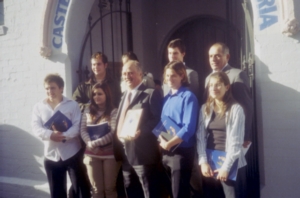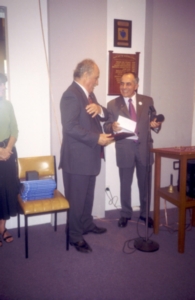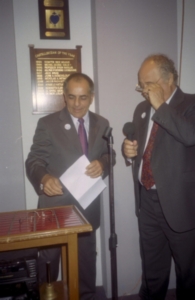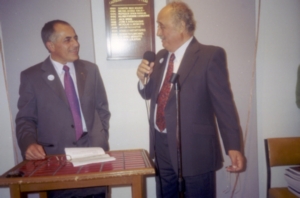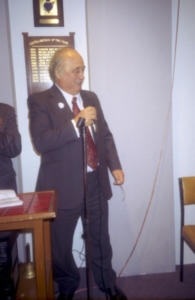Professor ERNEST DEMETRIOS HONDROS (Anastasios Demetrios Hondros) FRS; DSc; Dr d’U (Paris); FIM; C, Eng.; C.M.G.
Former Director of the Petten Establishment (1985 – 1989), Commission of European Communities’ Joint Research Centre (Netherlands).
Former Director of the Institute for Advanced Materials (1989 -1995),
The Petten (Netherlands) and Ispra (Italy) Laboratories of The Joint Research Centre, Commission of the European Communities. Superintendent, Materials Division of the National Physical Laboratory, Teddington, U.K. (1979-1985).
Current Position: Visiting Professor and Senior Investigator,
Department of Materials, Imperial College, University of London.
Titles, Awards and Honours:
FRS – Fellow of The Royal Society; C.M.G. -Commander of the Order of St. Michael and St.George; DSc – Doctor of Science, [Melbourne University, and University of London, UK (Honoris Causa)]; Dr d’U (Paris) –Doctor of the Universite de Paris, France; FIM –Fellow of the Institute of Metals; CEng;
Member of Academia Europaea; Member d’Honneur, Societe Francaise de Metallurgie; Rosenhain Medal (Metals Society, U.K.); Howe Medal (American Society of Metals); Griffiths Medal (Institute of Metals, U.K.); Committees, etc: Member of Court of Imperial College, University of London Chairman of Advisory Committee for Materials Department, Imperial College Member of Advisory Committee, Dpt. of Materials, University of Cambridge Member of Comite de Direction, C.N.R.S.Laboratoire, Universite de Dijon, France
Member of Comite de Direction, C.N.R.S. Laboratoire, Universite de Grenoble, France (C.N.R.S – Centre National de la Recherche Scientifique)
Member, Consiglio Nazionale delle Ricerche, Instituto di Chimica Fisica Materiali, Genoa, Italy Member of International Board for election of Heads of Institutes, University of Patras; and University of Thessalonike, Greece
External Examiner for Doctoral Theses for several U.K. and other European Universities Member of Editorial Committees for several learned Journals.
Publications: About 150 papers and articles on Physical Science research, published in various learned journals.
Lectures:
Numerous invited lectures to international Conferences and Universities
Distinguished lectures at Universities of Sheffield and Oxford.
Profile of E. D. HONDROS
Anastasios (Tasso) Demetrios Hondros was born in Kastellorizo, to Demetrios Hondros and Athanasia Paleologos. When he was eight years old, he and his family moved to North Queensland, Australia, to escape the Second World War. Anastasios could not speak any English when he started his education at the Cairns State Primary School. After completing his schooling at the Cairns State High School, his parents moved to Melbourne, in 1947, where he was able to attend Melbourne University, gaining his Masters and Doctor of Science. He was invited to further his studies at the Paris University, which led to his extensive European career.
In 1968 he was married to his beautiful wife, Kristine Garder-Olsen. Kristine and Tasso have two sons; Dimitri Alexandros, who holds a Masters in Economics from Essex University and currently works in Thessalonike; Constantine who holds a Masters in Science from Edinburgh University and currently works in Holland. Tasso and Kristine live in London, vacationing in Kastellorizo every year for the past 35 years. When Tasso is not working at the Imperial College, London, he tries to be at his home in Mandraki, Kastellorizo.
EXPLANATORY NOTES
The Petten Establishment was set up in the 1960’a as a nuclear research facility. In the 1970’s nuclear research was de-emphasized but nuclear materials testing and evaluation remained an important function until 1996.
As the Director of the Institute for Advanced Materials, Ernest Hondros was credited with the development of the Institute, over a ten year period, into a first rate research laboratory, establishing an international reputation in materials science.
• Sourced from the Office of Naval Research -European Office (1996).
The Royal Society.
The Royal Society of London was founded in 1660 by scientist including Robert Boyle, John Wilkins and Christopher Wren. Since its early history, the Society has elected scientists, engineers and technologists to become members of its Fellowship. The Society is made up the most eminent scientists, engineers and technologists from the UK and the Commonwealth. Each year the Fellows elect 44 new Fellows, chosen from across the science, engineering and medicine spectrum –an honour regarded as the highest accolade a scientist can receive and next only to a Nobel Prize. They also elect six Foreign Members each year.
Today, Fellows of the Royal Society include Nobel prize-winning scientists such as Paul Nurse (cancer researcher) and Peter Mansfield (whose work led to the development of magnetic resonance imaging or MRI). Other Fellows include mathematician and physicist Stephen Hawking; IVF and stem cell research pioneer Anne McLaren and inventor of the worldwide web, Tim Berners-Lee.
The Academia Europaea is a functioning European Academy of Humanities, Letters and Sciences, composed of individual members. Membership is by invitation. Invitations are made only after peer group nomination, scrutiny and confirmation as to the scholarship and eminence of the individual in their chosen field. Election is confirmed by the Council of the Academy.
Members are drawn from across the whole European continent.
C.M.G: Commander of the Order of St. Michael and St. George – a British award conferred by Queen Elizabeth. It was presented to Professor Hondros for “services to European sciences”.
Imperial College London is a part of the University of London.
The College has been enlarged since 1988 to incorporate a growing medical component. The full title of the college is The Imperial College of Science, Technology and Medicine. The Governance of the college consists of the Court of the Imperial College of S, T&M and the Council of the Imperial College of S, T, &M. The Court has over 150 members and incorporates representatives of all the learned institutions and royal societies associated with the pursuits and disciplines of the College. External members come from local councils, Parliament, teachers associations and include representatives from commonwealth countries. Twenty four elected academic staff and four elected academic related staff will serve on the Court for four years.
Professor Ernest Hondros is the representative of The Royal Society at the Court.

